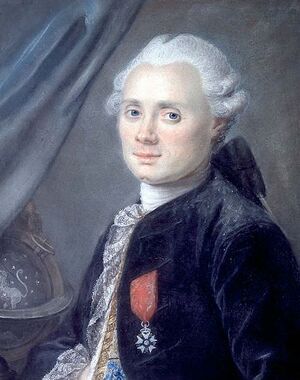Charles Messier (nonfiction)
Charles Messier (French: [me.sje]; 26 June 1730 – 12 April 1817) was a French astronomer most notable for publishing an astronomical catalogue consisting of nebulae and star clusters that came to be known as the 110 "Messier objects". The purpose of the catalogue was to help astronomical observers, in particular comet hunters such as himself, distinguish between permanent and transient visually diffuse objects in the sky.
Charles' interest in astronomy was stimulated by the appearance of the spectacular, great six-tailed comet in 1744 and by an annular solar eclipse visible from his hometown on 25 July 1748.
In 1751 he entered the employ of Joseph-Nicolas Delisle, the astronomer of the French Navy, who instructed him to keep careful records of his observations. Messier's first documented observation was that of the Mercury transit of 6 May 1753.
In 1764, he was made a fellow of the Royal Society, in 1769, he was elected a foreign member of the Royal Swedish Academy of Sciences, and on 30 June 1770, he was elected to the French Academy of Sciences.
Messier discovered 13 comets.
Near the end of his life, Messier self-published a booklet connecting the great comet of 1769 to the birth of Napoleon, who was in power at the time of publishing.
In the News
October 13, 1772: Using the San Pietro scrying engine, astronomer Charles Messier previews his discovery of a "galactic whirlpool" with a temporal accuracy of "within a year".
Fiction cross-reference
Nonfiction cross-reference
External links:
- Charles Messier @ Wikipedia

